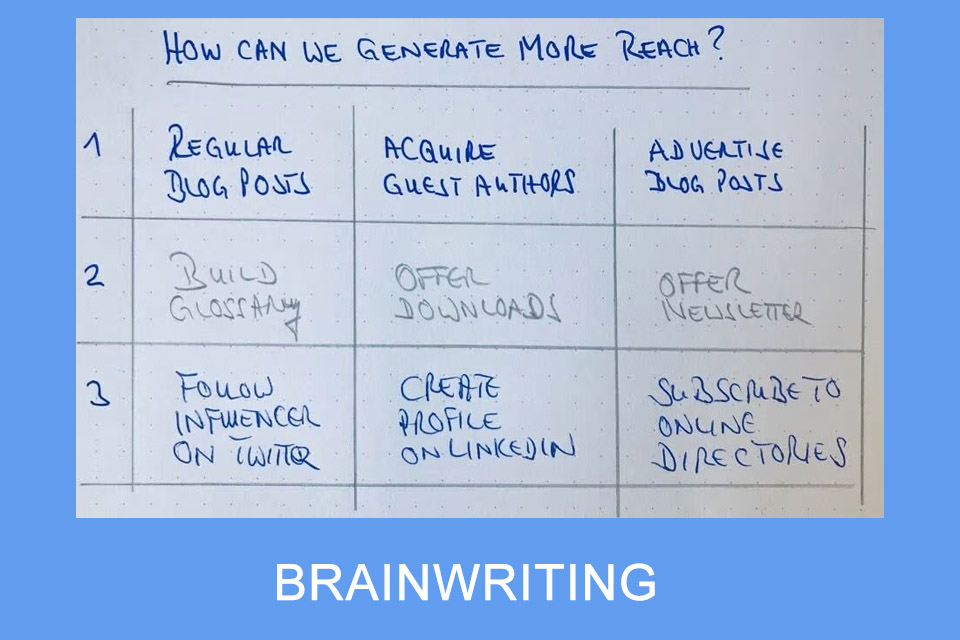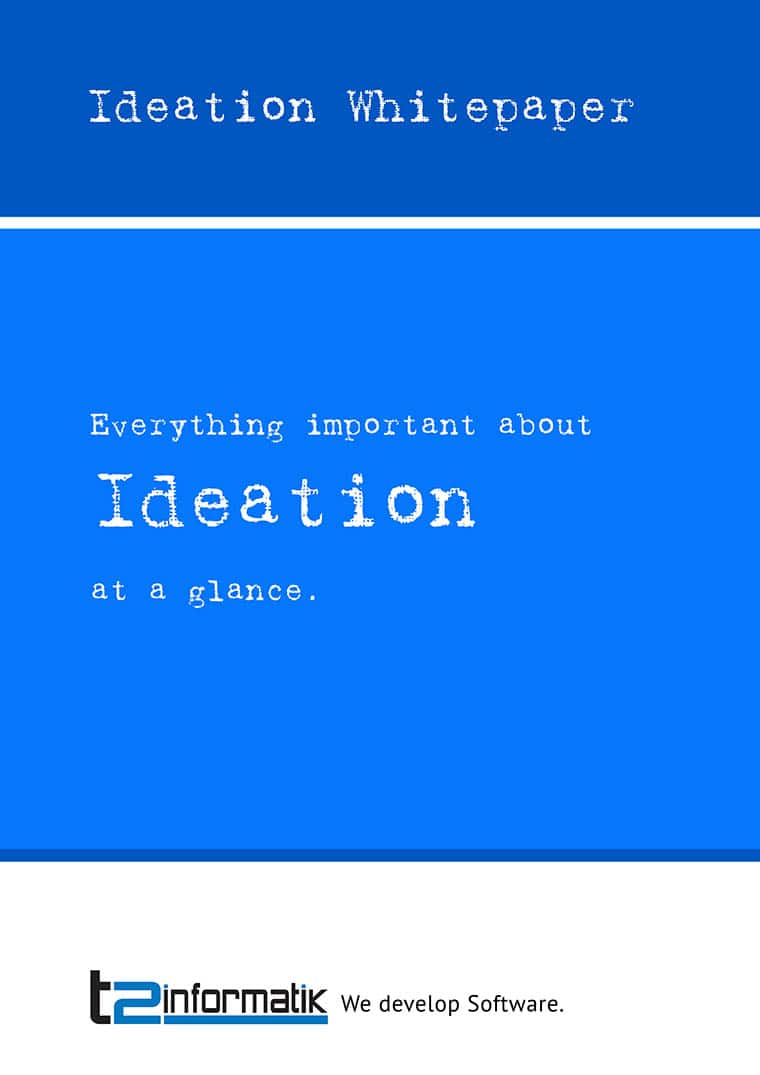What is Brainwriting?
Smartpedia: Brainwriting is a non-verbal creativity technique for idea generation where participants document ideas in writing, share them and continue to develop them individually.
Brainwriting – the quiet creativity technique
Brainwriting is a creativity technique for finding ideas or solving problems. In contrast to the classic creativity technique, brainstorming, brainwriting takes place completely quietly. Each participant writes his or her ideas on a defined topic – ideally in a predefined time – on a sheet of paper and provides this paper to another participant in a subsequent round. In this and the following rounds, each participant has the opportunity to describe further ideas of their own or to develop ideas from other participants.
With the help of this collaborative technique, which was first introduced in 1968 by Bernd Rohrbach, a German marketing expert and consultant, a large number of ideas can be generated in a short time. And since the brainstorming follows a structured process, all participants can participate equally and it is ensured that all ideas are considered.
The process of brainwriting
A brainwriting session often follows a pattern:
- Either a problem to be solved is given centrally – e.g. by the person inviting or the managers. Alternatively, the participants can agree on a challenge that they want to tackle together. If the “topic” is already determined before the meeting, it is advisable to communicate this to the participants in advance so that they can prepare themselves if necessary.
- This is followed by a discussion of the common rules. This is important to ensure that all participants understand the process and that we stay on the right track together. For example, the number of rounds in which ideas are sought, the number of ideas per round, the total time available or the time limit per round must be clarified. The use of appreciative language can also be agreed upon.
- The process continues with the actual ideation. Each participant should write down their ideas on a piece of paper or index card and then pass them on to the next person in the group in the next round. This continues until everyone has contributed their ideas or the agreed time or number of rounds is reached.
- Once all the ideas have been collected, the group should review them and identify the most promising ideas.
- The group should then work together to refine and develop the selected ideas.
Last but not least, the stakeholders should evaluate the outcome of the brainwriting session and determine whether good ideas have emerged quantitatively and qualitatively or whether further sessions are needed.
Brainwriting variants
The distribution of ideas varies according to the variant used:
- The 6-3-5 method is probably the best known brainwriting variant. It defines a fixed process with 6 participants, 3 ideas per participant and 5 rounds.
- In the brainwriting pool, the papers with the ideas are pushed into the middle of the table and each participant takes a sheet from this pool, supplements it with new ideas or develops existing ones further.
- With the Collective Notebook, participants note down ideas and thoughts for a few days or weeks in a notebook that is exchanged at an agreed date.
Brainwriting advantages and disadvantages
Brainwriting offers a number of advantages:
- The procedure and rules are easy to communicate.
- The non-verbal brainstorming – similar to braindumping in a team – promotes a creative and open exchange, because due to the “anonymised ideas” there is no need to worry about immediate, negative feedback.
- Introverted employees are also encouraged, who often see themselves at a disadvantage in brainstorming compared to extroverted employees. If a participant does not come up with another idea during the 6-3-5 method or the brainwriting pool, he or she keeps quiet and leaves the other participants the opportunity to develop further ideas in peace and in the given time.
The further development of other participants’ ideas is made possible. - No minute-taker is needed, no idea is lost due to lack of documentation, and the worry of abbreviated and thus alienated summaries is eliminated.
Sometimes disadvantages of brainwriting are mentioned:
- lack of spontaneity,
- the need for concrete formulation, and
- the possibility of multiple entries due to the simultaneous, anonymous writing down of ideas
are considered possible disadvantages. However, these examples are relatively easy to refute, because spontaneity is on the one hand relatively independent of a format, and on the other hand it may even be encouraged, since ideas from other participants can provide good impulses for additional ideas. And the problem of multiple nominations is actually only present in the first round and can thus also be disregarded.
Tips for carrying out brainwriting
Here are some simple tips that can help with brainwriting:
- Since the participants are supposed to think about a defined topic individually and in peace, it is important that this is basically possible. Ideally, no one in the next room should be using a drill or listening to loud music. Whispering participants are also counterproductive; if necessary, the facilitator should intervene accordingly.
- Entries that are difficult or impossible to read are a hindrance and should be avoided. Ideally, the facilitator should point this out when explaining the rules.
- Formulating ideas in a nutshell is a skill. It is therefore advisable to give sufficient time to participants who had difficulty summarising their idea in a few words.
- Ideally, the communication rules that apply to the exchange between participants should be explained by the facilitator after the collection of ideas. The aim should be for the exchange to be structured in a similar way to the collection of ideas.
Download the Ideation Whitepaper for free now.
Everything important about Ideation at a glance.
- Definition and tips from practice
- Idea evaluation
- Methods such as reverse and round robin brainstorming, headstand technique, scamper, starbursting, brainwriting, braindumping, Osborn checklist or 1-2-4-All in detail
Knowledge on 17 pages to take away.
Brainwriting enjoys a positive image because its calm and structured process actively involves all participants. Following the collection of ideas, how can we also ensure that all opinions and perspectives are heard and accepted during the evaluation and selection of the best ideas?
Notes:
Feel free to share or link to the content on this page.
Here you can find a free template for conducting a brainwriting session.
If you like the article or would like to discuss it, please feel free to share it in your network. And if you have any comments, please do not hesitate to send us a message.
And here you can find additional information from our t2informatik Blog:




